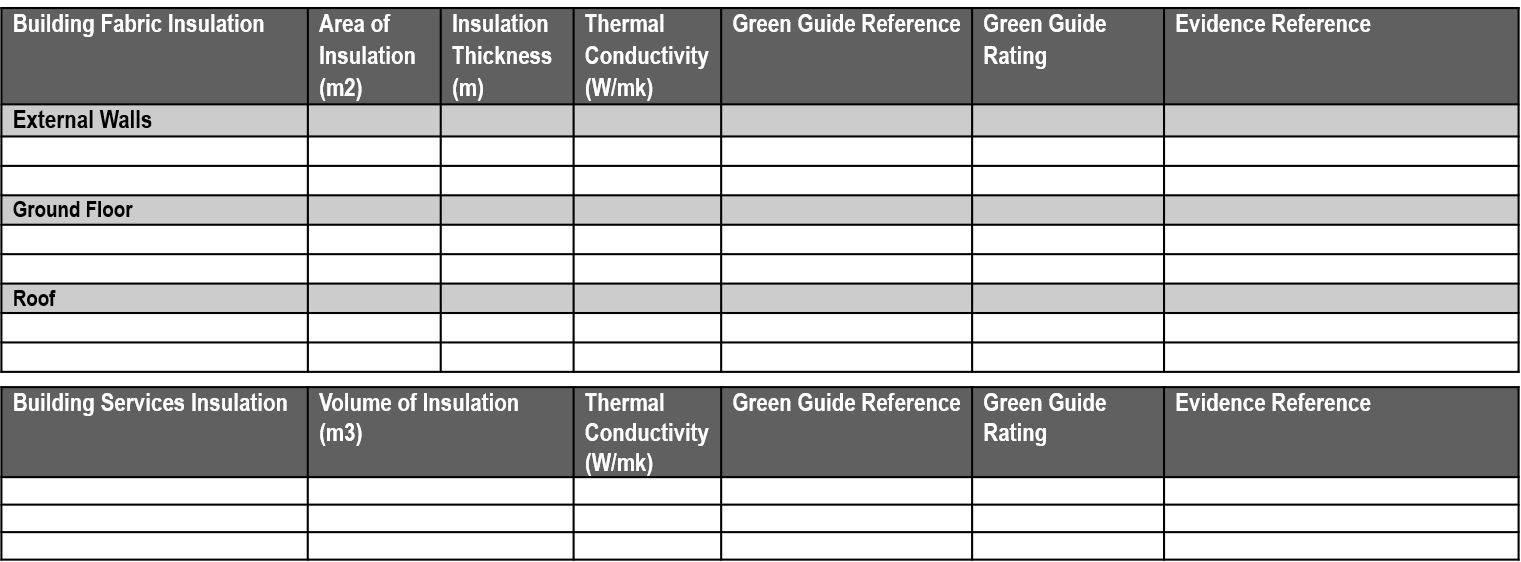BREEAM Insulation
Contents |
[edit] Aim and benefits
To recognise and encourage the use of thermal insulation which has a low embodied environmental impact relative to its thermal properties.
Credits are awarded based on an insulation product's Green Guide Rating score multiplied by the thermal resistance (thermal conductivity value x volume ). Where an Environmental Product Declaration (EPD) exists, this can be used to increase the score.
[edit] Value to Clients
This is the most certain way to achieve thermal comfort without ‘eco-bling’ and reduce energy costs. It is also a relatively low capital cost input.
[This section is no longer separated in NC 2018]
[edit] When to consider
The issue should be considered once the detailed and technical design stages commence and insulation materials are being selected i.e. RIBA Stages 3 to 4 and at a stage where the assessor/BREEAM AP are still able to influence the choice of materials used to ensure compliance.
On shell or shell and core projects, only the insulations being installed during that phase of works needs to be considered.
On Refurbishment & Fit Out Projects, this issue is not applicable to Part 4.
On Refurbishment & Fit Out Projects, where there will be no new insulation, this issue will be filtered out.
[edit] Step by step guidance
The design team should complete a schedule to confirm the insulation products used. The assessor can help apply any green guide ratings. This will cover all insulation used in the thermal envelope - external walls, roof and ground floor, and in the building services.
Evidence to be collated for each product, will include technical literature or product data sheets confirming the insulation type and thermal conductivity, green guide rating or EPDs.
Where a product requires a bespoke green guide rating, the assessor will need to submit an Insulation Proforma to the BRE (available to assessors on BREEAM Projects under Documents - Green Guide to Specification - Assessor information).
The data provided should be input into the Mat04 Calculator Tool to confirm the Insulation Index score - 2.5 is required to gain a credit.
[edit] Questions to ask while seeking compliance
What insulation is being specified and where, its thickness and area (or for building services - the volume)?
[edit] Tools and resources
BREEAM UK New Construction 2014 Issue 5.0 - Mat04
GreenBookLive link to search EPDs
[edit] Tips and best practice
Where insulation is incorporated as part of an off-site manufactured element, this will have been assessed under Mat01, the insulation can therefore be awarded an A+ rating under Mat04.
[edit] Typical evidence
[edit] Design Stage
Drawings and/or specification or completed Mat04 Schedule (example under Step by Step Guidance section. Manufacturer's data sheets. Copies of any Environmental Product Declarations (EPDs) where applicable. Print off from GreenBookLive to show green guide rating for specific product and building type where EPDs are being used.
A copy of the completed Mat04 calculator tool.
[edit] Post Construction Stage
Written confirmation from the design team to confirm the information provided at design stage is still current or a copy of the updated Mat04 schedule. Where required, an updated copy of the Mat04 calculator tool. Where available, photos of the insulation on site could be used as evidence.
[edit] Applicable Schemes
The guidelines collated in this ISD aim to support sustainable best practice in the topic described. This issue may apply in multiple BREEAM schemes covering different stages in the life of a building, different building types and different year versions. Some content may be generic but scheme nuances should also be taken into account. Refer to the comments below and related articles to this one to understand these nuances. See this document for further guidelines.
- UK New Construction 2014
BRE Global does not endorse any of the content posted and use of the content will not guarantee the meeting of certification criteria.
<Jane Morning>
Featured articles and news
RTPI leader to become new CIOB Chief Executive Officer
Dr Victoria Hills MRTPI, FICE to take over after Caroline Gumble’s departure.
Social and affordable housing, a long term plan for delivery
The “Delivering a Decade of Renewal for Social and Affordable Housing” strategy sets out future path.
A change to adoptive architecture
Effects of global weather warming on architectural detailing, material choice and human interaction.
The proposed publicly owned and backed subsidiary of Homes England, to facilitate new homes.
How big is the problem and what can we do to mitigate the effects?
Overheating guidance and tools for building designers
A number of cool guides to help with the heat.
The UK's Modern Industrial Strategy: A 10 year plan
Previous consultation criticism, current key elements and general support with some persisting reservations.
Building Safety Regulator reforms
New roles, new staff and a new fast track service pave the way for a single construction regulator.
Architectural Technologist CPDs and Communications
CIAT CPD… and how you can do it!
Cooling centres and cool spaces
Managing extreme heat in cities by directing the public to places for heat stress relief and water sources.
Winter gardens: A brief history and warm variations
Extending the season with glass in different forms and terms.
Restoring Great Yarmouth's Winter Gardens
Transforming one of the least sustainable constructions imaginable.
Construction Skills Mission Board launch sector drive
Newly formed government and industry collaboration set strategy for recruiting an additional 100,000 construction workers a year.
New Architects Code comes into effect in September 2025
ARB Architects Code of Conduct and Practice available with ongoing consultation regarding guidance.
Welsh Skills Body (Medr) launches ambitious plan
The new skills body brings together funding and regulation of tertiary education and research for the devolved nation.
Paul Gandy FCIOB announced as next CIOB President
Former Tilbury Douglas CEO takes helm.
UK Infrastructure: A 10 Year Strategy. In brief with reactions
With the National Infrastructure and Service Transformation Authority (NISTA).























